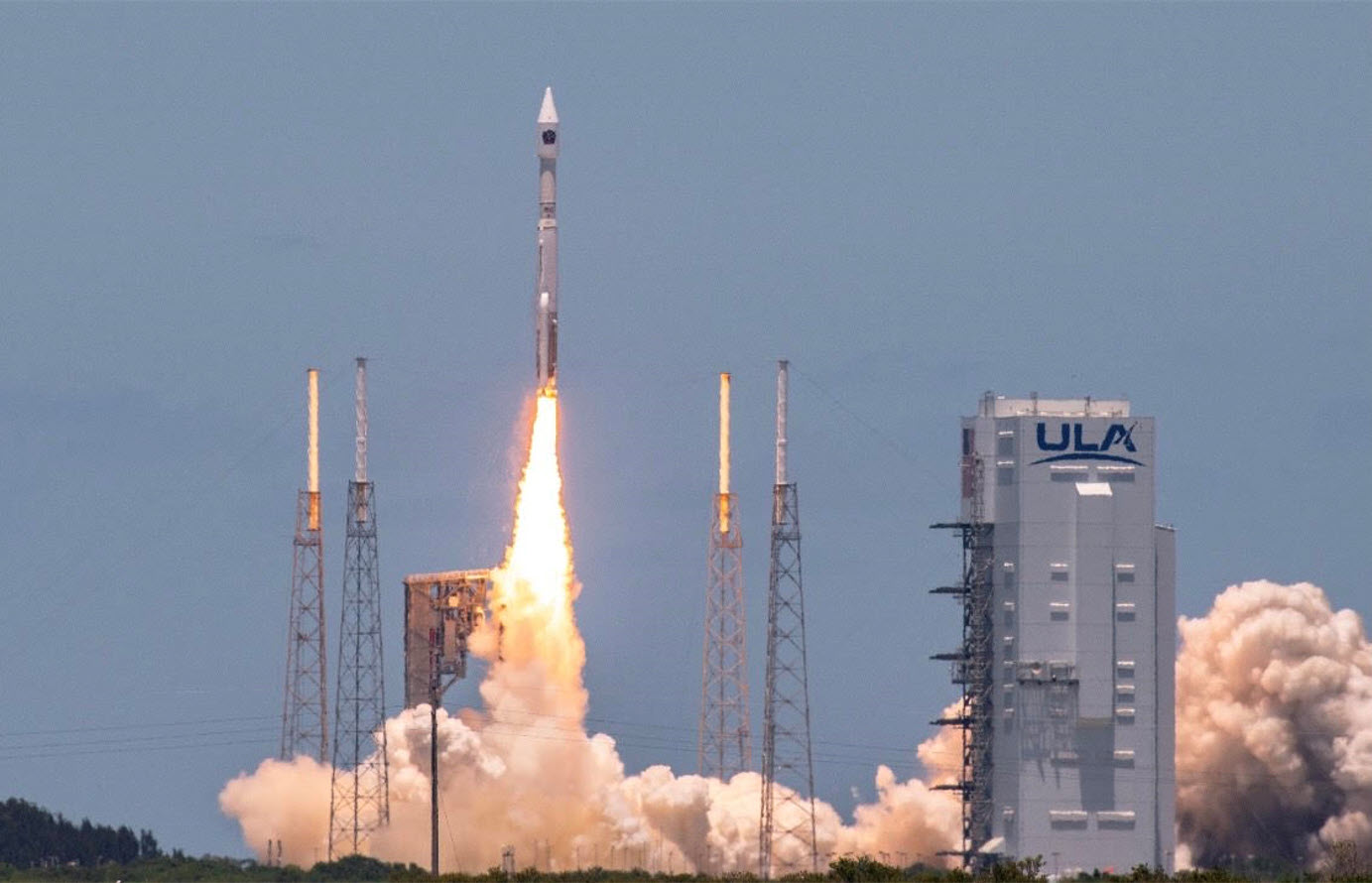
Space Based Infrared System (SBIRS) geosynchronous Earth orbit satellite on an Atlas V launch vehicle from Space Launch Complex 41 at Cape Canaveral Space Force Station, FL, in May 2021.
There are several major trends today in space-based early warning/missile warning. The first is the ongoing effort to modernize the Space-Based Infrared System (SBIRS). Earlier this year, U.S. Space Force launched the fifth SBIRS satellite into geosynchronous Earth orbit (GEO).
The Defense Department’s next step is development of a missile-warning architecture that is layered among low-Earth orbit (LEO) and medium-Earth orbit (MEO) orbits in order to complement SBIRS and the forthcoming Next Generation Overhead Persistent Infrared payloads in GEO and Polar orbit. Such a multi-orbital, layered architecture, which is also applicable to various other space-based capabilities, will provide capability to U.S. space operations to counter potential threats by near-peer adversaries.
Raytheon Intelligence & Space (RI&S) is actively involved in developing the sensors for all of those orbital regimes, which we discussed with Roger Cole, executive director of strategic systems for space within RI&S.

Roger Cole, Executive Director of Strategic Systems for Space, Raytheon Intelligence & Space.
Breaking Defense: Why is space-based missile warning architecture a focus right now?
Cole: There are new threats and the U.S. needs new ways to track these threats. Space is becoming an increasingly contested environment. The U.S. and our allies require persistent global-sensing coverage with low-latency communications to update the common operating picture in real time while providing a more resilient space-based sensor architecture.
Working in tandem with existing and new national asset systems, a multilayered approach in the orbits of LEO, MEO, GEO, and Polar orbit can collaboratively provide a holistic view along with sea- and ground-based sensors. Overhead Persistent Infrared systems operating in multiple orbital regimes increases the effectiveness of threat tracking and processing and increases resiliency.
It is operations in these different orbital regimes that allow faster and more holistic responses to the evolving threats and acquire an overall network view. That’s because satellites in LEO and MEO provide favorable viewing geometries of the Earth for tracking objects that are moving differently than the ballistics we’ve seen before, such as hypersonics. GEO satellites that provide persistent stare on the entire Earth surface, are especially important to the missile-warning mission.
Breaking Defense: There is a lot of risk in space systems and Space Command wants to reduce risk. How is RI&S using digital engineering methods to support rapid development of missile warning architectures?
Cole: Right now, RI&S can deliver transformative capabilities, with speed being the main enabler. This requires an understanding of the threat, application of modern development methodologies, leveraging best practices in design, development, production, and reuse of proven, existing technology.
This starts with modeling and simulation tools developed at RI&S to do architectural trade studies that identify robust mission performance in different scenarios involving ballistic and hypersonic threats.
RI&S uses modeling and simulation to demonstrate effectiveness of different architectures and approaches, which can help inform the requirements for missions. Modeling and simulation can also help improve how our customers use that technology and what strategic investments should be made. Architecture trades studies assess investments in one large system like the heritage programs, and can help answer questions like, can multiple smaller systems in alternate orbits be less expensive in order to create more capability and resiliency?
Modeling and simulation help us understand a large trade space of missile warning and defense options so we’re able to provide the best value to the nation. That includes using our digital tools to help reduce risk by identifying design improvements early on in the development phase.
Breaking Defense: What makes RTX qualified to offer end-to-end missile protection and warning in LEO, MEO, GEO, and Polar orbits?
Cole: The biggest strength RI&S has is that since our merger in 2020, Raytheon Intelligence & Space continues to have access to Raytheon Missiles & Defense, which are both now business units of Raytheon Technologies. Raytheon Missiles & Defense understands both effectors that can take out potential space and airborne threats, as well as advanced ground- and ship-based sensors, which means that RI&S now can support the entire kill chain using the knowledge that’s been shared across Raytheon Technologies.
Raytheon Technologies’ missile defense portfolio combines sensors, interceptors, and command and control networks to track and defeat a wide range of threats across all domains. Today, the company is responsible for portions of nearly every air and missile defense system deployed by the U.S. and its allies.
In addition, our majority owned joint venture, RGNext, (Range Generation Next, a joint venture of Raytheon and General Dynamics Information Technology) manages 90 percent of DoD launches. So, we also have a comprehensive understanding of launch operations.
Breaking Defense: Final thoughts?
Cole: One of the key reasons that missile warning and defense modernization is needed is that the U.S. needs to have wider and more resilient coverage.
I’ll double back and say that the layering we discussed goes beyond just the orbital regimes to include the number of satellites. We can continue to rely on national-asset-class systems and also place increased focus on providing similar capabilities with multiples of smaller satellites. That will provide more coverage in more orbits with multiple constellations that give us resiliency and the ability to reconstitute faster if we lose one or more so that the whole system doesn’t shut down. It’s about having layered redundancy in terms of orbital regime, satellite count, and on-board processing.
We’re also working on connecting our sea and ground sensors to these space-based sensors, which leads into the DoD’s emphasis on Joint All Domain Command and Control, as well as distributed operations. The ability to sense from sea to ground to space will give the U.S full coverage that is so critical right now.























